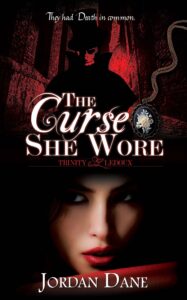Jordan Dane
@JordanDane

Wizarding World of Harry Potter : Hogwarts
What makes a book setting memorable? We have all read books where the setting gripped us and drew us in as readers, but any setting takes research to develop the world we will portray in our books. Even settings we are familiar with, like a hometown, take vision to add to the plot we will develop. It takes even more to create a fictional world no one has ever known or a futuristic setting we want to make vivid in the reader’s mind. Some vivid setting books that come to mind for me are: the Hunger Games series, Harry Potter, and Game of Thrones. If you have a series in mind, your canvas for storytelling must be large and hold its mysteries for future plot lines. A good setting can become a character in your books.
Many new or aspiring authors don’t include much of a setting. They tend to focus on their plot, the actions of the characters and the dialogue, but any setting can enhance a scene or a book.
Here is an excerpt from THE CURSE SHE WORE with a sprinkle of setting to enhance the mood of the scene – in the voice of Trinity LeDoux.
French Quarter
Rain sluiced from rooftops and pinged through metal rain gutters as if God had given up and flushed the world. I knew the feeling, the ache and emptiness of loss, especially tonight.
Mixed with the din of the rain, Dixieland jazz and Zydeco grated on my nerves. I had no tolerance for good cheer. Not tonight. I only had a taste for straight up bourbon and the severed artery of soul sucking blues, but where I headed I’d get neither.
I clutched the vintage necklace I’d worn to remind me why I had to come.
When I look back at the stories I have written, especially after I wrote my debut book NO ONE HEARD HER SCREAM in my old hometown of San Antonio, I did NOT pick safe bets. I often wrote in the best setting for the plot I had in mind, even if that meant writing about locations I had never been. Since I had traveled, I knew what it felt like to navigate in a world where I didn’t know the language or where to go. I could use any of my experiences to color the world of my characters or I could invent things to throw in their paths to make challenges. My empathy and imagination would help make the plight of my characters “relatable.”
When I wrote my latest novel – THE CURSE SHE WORE – I picked New Orleans as the setting. I had been to NOLA a few times, but that didn’t make me an expert. I used advisers that knew New Orleans well. I picked their brains & listened for the subtle nuances of local lingo & iconic venues. These experts helped provide me with the color & the history that I would want added to my series. It can be a rabbit hole to chase down the things that interest you about a location, but if you don’t use the material in your current project, you may save the notes for future plots. A writer’s brain is like a sponge, thirsty for knowledge.
Here are key examples of things you should know about your setting to add depth:
1.) What is the culture and ethnicity of your setting? Are their inherent conflicts with differences?
2.) What key events in history helped shape & influence your setting? History can define people and social morays. It pays to know the history of the world you are either creating from scratch or researching for accuracy.
3.) Add subtext for your setting that is reflected in your character’s attitude or mood. Try having your setting mirror the mood or attitude of your character to add context. You do this by making deliberate choices on what your character notices about the setting that reflects or mirrors their mood. For example, if a young woman walks into a bar filled with men who stare at her as if she were a porterhouse steak, what would she notice? What would crawl under her skin about the setting? The dirt, the smells, the sounds that grate on her nerves.
I love playing off the setting to enhance a scene. For example, here is my character Trinity LeDoux as she is introduced to the opulent plantation estate of Hayden Quinn, the psychic she must convince to join her on a perilous mission. She has never known wealth or power but she sees it everywhere in Quinn’s world.
Excerpt: The Curse She Wore
Ivory Magnolia Plantation
I’d never sat under a thousand sparkling rainbows before.
The crystal chandelier in Hayden’s dining room cast pastels onto the lace tablecloth. Expensive wood-carved furniture surrounded me and made me feel small. In Quinn’s world, normal meant something else entirely, something I’m not sure I would ever figure out.
I had a grasp that my life wasn’t normal, but I couldn’t say whether Hayden Quinn’s world was any closer to that mark. The man was cocooned as much in history as in his comfortable wealth—but with a gift that stamped him as an abiding freak by most people.
Normal? Not even close.
Paintings on the wall turned the room into a museum—as close as I’d ever get to such comely abundance—but when Quinn lit candles for the occasion, the soft glow from the majestic candelabras made me drowsy with contentment. He could’ve confused me with fancy utensils and proper china plates, but he’d kept things simple.
I had no doubt he’d done that for me. He’d welcomed me into his world with more grace than I had a right.
4.) Use your fives senses to place the reader there, but don’t go overboard. Don’t pull the reader from your writing by deliberately citing each sense as if you are doing an inventory. Pick the most critical and visual and go for it.
5.) Use visual aids to tease into your settings. If you have an iconic location, pick one or two images that readers may know and insert them into your story. Integrate them naturally. When I researched the streets of White Chapel in THE CURSE SHE WORE, I loved finding old maps to help me visualize where my character would’ve walked and what she might’ve seen as she went. History books are great for this and there are online resources that can help.
6.) Use action to incorporate setting details into your scenes to be more subtle about the use of your research. Action can be a great way of merging plot with research in a natural way.
Excerpt from THE CURSE SHE WORE (in Victorian London, late 1800s):
“This is where you live?”
I feared for the girl and her Alfred. No wonder she’d brought the dog with her.
Dorset Street was still a hive of activity, even at this hour. Disheveled beggars hustled for any handout and street merchants hawked their wares and services. Their voices reverberated off brick to magnify the sound. I would’ve paid for silence.
Women huddled on corners, eyeing every man who walked by and making offers. Some were mothers in stained frocks who clutched at their crying babies. A mother’s duty to provide knew no limits.
I had a bad feeling on where the girl would head next as she ducked down a flagged passageway, next to McCarthy’s store. A lone gas lamp cast shadows into a narrow and dismal courtyard that would never see sunlight even at noon.
It had a public water spigot dripping rust onto cobblestone and a common toilet that smelled as if it had backed up. As I peered into the court, I took in the steady noise and imagined the life of a girl in this forsaken corner of hell. The brick walls didn’t cover up the sounds of squeaking beds and fake orgasms, or the constant noise from a small pub on her doorstep.
7.) What food best portrays your location? Many times you have only a few spots where you can showcase food to color your world. What would you pick as quintessential? I often use a real restaurant and research their menu to include in my book. Can my character afford the prices? Make it real. That way, if a reader knows the location or looks into the details, they can find the real venues and connect deeper to my books.
Word of caution – I like to use real restaurants when I can, but if I write something bad in my plot that happens in that establishment, I will only go with a fictional name for the location. I may tease the reader with a setting that’s similar to a local restaurant, but I would call it something different. For example, in my debut book NO ONE HEARD HER SCREAM, I burned down a historic theatre. I pictured the Majestic Theatre, but I called it by another fictional name. I would be drawn and quartered if I had burned down a real theatre as popular as the Majestic. I also described the iconic Fig Tree Restaurant on the Riverwalk, but called it another name because my crime boss had dinner there. I didn’t want to give the restaurant a bad name.
8.) What are the street sights and sounds as your character walks through your setting? You can imagine a typical street but when you go the extra mile to describe certain characteristics, the reader may know your setting well enough to appreciate it.
9.) What is the geography/terrain or weather in the region? How does it affect your story? Look for seasonal weather forecast averages for the time of year you are choosing for your story. Google Maps can help define the regional geography. Even if you don’t use much of this kind of information, it can help to add layers to your story if you give the reader glimpses, as if you have been there. (I have never been to South America, but when I had Brazilian advisers who read through some of my books for authenticity, they came back with great feedback – that they were homesick for their country. That really made my day.)
10.) What is the local language or slang for places, events and common sights? This can be a tough challenge. Local slang is hard to pin down, but look on social media pages/sites to get a start & read the comments to blog posts to find the local lingo. (For example, in Dallas Hwy 75 is called Central Expressway. Despite politicians renaming a northern section of it, most locals will always call it “Central.” Or the locals in New Orleans don’t use the full name for the French Quarter. They may simply call it “the Quarter.”)
11.) What is the flora and fauna of the region? When I wrote about a remote area in Alaska for THE LAST VICTIM, I contacted the Chamber of Commerce on the island and talked at length with Grace, a newfound friend. She not only sent me many brochures on the island, she also sent me personal photos of the exact areas I needed. She had hiked there many times. She was a wealth of knowledge for how the natives lived on the island and even how they brewed an herbal tea they called Swamp Tea, common to many households. This type of information is pure gold when you’re a writer.
12.) What do the locals do for entertainment? These activities can vary by how much it costs to do these things. Not everyone can afford the same entertainment.
13.) Imagine where your character may go in your setting location and research those places. Bistros, libraries, entertainment, homes in the area, & public buildings they might frequent.
14.) What are the local newspapers? I used this in several of my books, but it’s always fun to imagine what my characters would do to get information and make it feel real to readers.
RESOURCES:
Contact Visitors Bureaus and Chambers of Commerce – These organizations can be invaluable to get you started. Don’t be shy about speaking to someone. You never know who you will meet over the phone.
Research Locations on Social Media – Many places, like New Orleans, have Facebook pages and other social media. Don’t stop at the official sites. Look for realtors selling properties in the area or food/entertainment resources and other key sites to get your juices flowing over your plot.
Youtube/Vimeo – I did a huge amount of research on mountain climbing (something I would never have experience for) in my YA book – ON A DARK WING. I had friends who had made the climb up Denali, the challenge one of my characters faced, but there was also many videos of climbers who had traversed Everest. Videos from inside their freezing tents with winds howling. These are things an expert might not share with you.
Internet Image Searches – Look for images for the setting you are researching. Many times, a picture can jump start ideas on characters, plot or events. Create a vision board for ideas that give you the flavor you are searching for and immerse yourself in that world as you write.
Music – What sounds do you hear when you think of the location? Do you ever listen to certain music before you write or AS you write, to get in the mood? Take the time to get to know your locale or invent a new one.
Libraries – Libraries are a great way to research ANYTHING. They often carry newspapers and periodicals from your locale or they can be a resource for non-fiction books on the subject. When I wrote THE CURSE SHE WORE, I used Liza Picard books to color my Victorian London historical world.
Google Street View Maps – I call this “walking with yellow man” – the little yellow icon you can click and drag to what street view you want to see. I have picked scary/crime ridden areas of my setting to find specific locations for creepy stuff to happen and I describe it. Whether a reader knows I have done this, it doesn’t matter. The visual preparation stimulates my writing and I love going the extra mile to make things real FOR ME. Here is the app for Google Streetview from Google Store. I have this on my phone. I can search a street view to see it like my character would. Very cool.
In summary, I have always loved having a layer of setting in each scene and it’s especially gratifying for me to select the right location for my book’s setting where I can reflect my character’s emotional journey. Over the years, I have found different resources to build on my process. I hope this post will get you to think about and appreciate your own process. Please share your tips.
DISCUSSION:
1.) Have I missed anything? Please share what you do to research setting for your books. Bonus points if you provide resource links.
2.) Are there tried and true methods you implement to research your settings? Describe your process.
2.) What are settings you have written (or read about) that you are most proud of as a writer or have stuck in your mind as a reader? What made it so authentic?

The Curse She Wore
They had Death in common…
Homeless on the streets of New Orleans, Trinity LeDoux has nothing to lose when she hands a cursed vintage necklace to a wealthy, yet reclusive clairvoyant.
During a rare public appearance, Hayden Quinn is unexpectedly recruited into Trinity’s perilous mission–a journey back through time to the exact moment of death for two very different victims.
Hayden and Trinity, two broken people with nothing but death in common, pursue the dangerous quest to stop a murderer from emulating the grisly works of a notorious serial killer. But trespassing on Fate’s turf comes with a price–one they never see coming.












